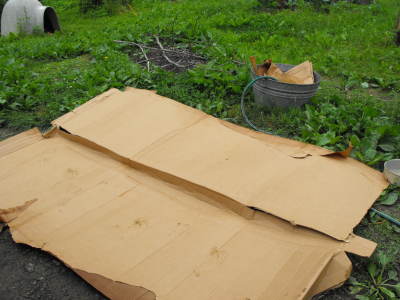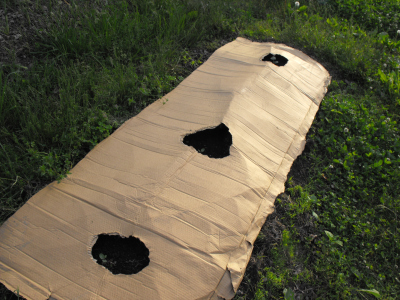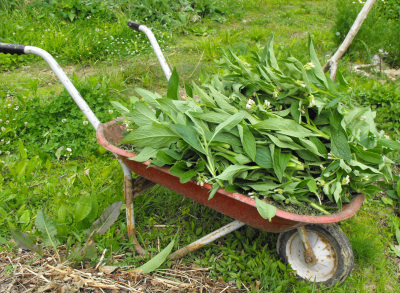
Cardboard and comfrey mulches
 Last
week, I detailed the
results of my first summer mulch experiment, noting that cardboard is a
potential winner. Meanwhile, Mom found a stash of huge boxes
being thrown away and snagged them for my continuing mulch
experiments. I'm trying the cardboard out on some cucurbits and
okra, as well as on two troublesome, weedy beds that need a kill
mulch. Sister cucurbit and okra beds are being left bare for
comparison.
Last
week, I detailed the
results of my first summer mulch experiment, noting that cardboard is a
potential winner. Meanwhile, Mom found a stash of huge boxes
being thrown away and snagged them for my continuing mulch
experiments. I'm trying the cardboard out on some cucurbits and
okra, as well as on two troublesome, weedy beds that need a kill
mulch. Sister cucurbit and okra beds are being left bare for
comparison.
 Despite
the fact that I soak the cardboard well before using it as a mulch, I'm
a bit concerned that it might be too slick for easy rain
penetration. I'll keep a close eye on the cardboard-mulched
plants and perhaps add some organic matter on top of the cardboard or
punch small holes in it to increase water penetration. As Mark
pointed out, if I can work the kinks out of cardboard mulch, there's a
neverending supply in nearby towns and it's much easier to transport
than other mulches.
Despite
the fact that I soak the cardboard well before using it as a mulch, I'm
a bit concerned that it might be too slick for easy rain
penetration. I'll keep a close eye on the cardboard-mulched
plants and perhaps add some organic matter on top of the cardboard or
punch small holes in it to increase water penetration. As Mark
pointed out, if I can work the kinks out of cardboard mulch, there's a
neverending supply in nearby towns and it's much easier to transport
than other mulches.
 In
other mulch news, last year's newly transplanted comfrey patches are now big enough
that I'm cutting them biweekly, adding the low C:N mulch to
select garden beds. So far, comfrey seems to be equivalent to
grass clippings as a mulch --- providing fertilizing power, breaking
down quickly, but letting some weeds through. I have to mention
that the bumblebees continued to feed from the cut flowers for over 24
hours after they were detached. Another reason to plant comfrey
in your yard...as if you don't have enough reason already!
In
other mulch news, last year's newly transplanted comfrey patches are now big enough
that I'm cutting them biweekly, adding the low C:N mulch to
select garden beds. So far, comfrey seems to be equivalent to
grass clippings as a mulch --- providing fertilizing power, breaking
down quickly, but letting some weeds through. I have to mention
that the bumblebees continued to feed from the cut flowers for over 24
hours after they were detached. Another reason to plant comfrey
in your yard...as if you don't have enough reason already!
| This post is part of our Farm Experiments lunchtime series.
Read all of the entries: |
Want more in-depth information? Browse through our books.
Or explore more posts by date or by subject.
About us: Anna Hess and Mark Hamilton spent over a decade living self-sufficiently in the mountains of Virginia before moving north to start over from scratch in the foothills of Ohio. They've experimented with permaculture, no-till gardening, trailersteading, home-based microbusinesses and much more, writing about their adventures in both blogs and books.
Want to be notified when new comments are posted on this page? Click on the RSS button after you add a comment to subscribe to the comment feed, or simply check the box beside "email replies to me" while writing your comment.

I have the same concern about water penetration with sheets of cardboard and/or newspaper.
Perhaps soaker hoses underneath the cardboard might help?
Another idea is to tear the cardboard up before laying it around plants. Water would be able to penetrate through the overlapping tears, but it should still suffocate weedlings. Dunno.